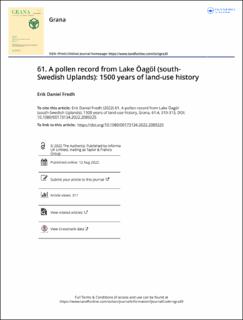61. A pollen record from Lake Öagöl (south-Swedish Uplands): 1500 years of land-use history
Peer reviewed, Journal article
Published version

Permanent lenke
https://hdl.handle.net/11250/3055818Utgivelsesdato
2022-08Metadata
Vis full innførselSamlinger
- Articles (AmS) [145]
- Publikasjoner fra CRIStin [4377]
Originalversjon
Fredh, E.D. (2022) 61. A pollen record from Lake Öagöl (south-Swedish Uplands): 1500 years of land-use history. Grana, 61 (4), 310-313. 10.1080/00173134.2022.2089225Sammendrag
Lake Öagöl (57° 12′ 34″; 14° 48′ 03″) is situated in the central part of the province of Småland, southern Sweden, a region characterised by mixed woodlands and small-scale agriculture. The investigated lake has a circular to squarish shape and covers 1.8 ha. A minor road runs through the catchment area (which is 22 ha) on the western side of the lake (approximately 100 m from the lake shore). The nearest village is situated about 2 km away. Historical maps from the nineteenth century show that cultivated fields and hay meadows were situated close to the village. The maps also show that the immediate area around the lake was part of the land, which was mainly used for grazing and wood resources, and that the nearest hay meadow was approximately 500 m away. Today, the land-cover around the lake is mixed woodland, dominated by spruce plantations. On the western side of the lake catchment is a local nature reserve (Kråketorpsskogen, 200 ha), which is protected from modern forestry.
